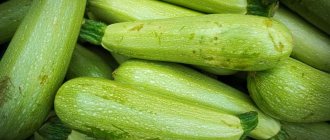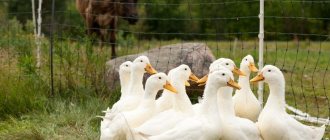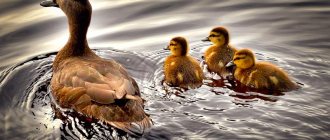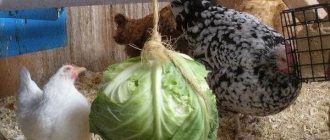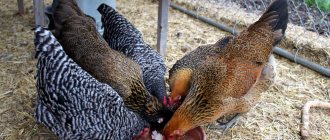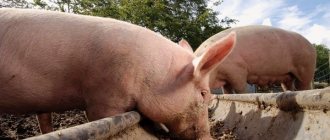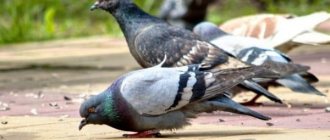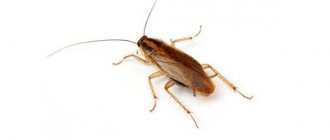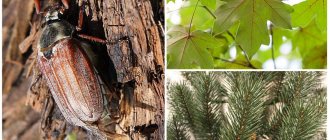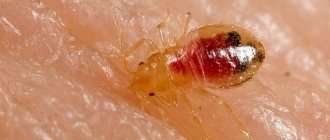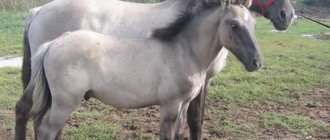Since ancient times, our ancestors have used horses as a form of transport, as well as draft power for transporting goods and heavy carts. Breeding horses for meat has also gained some popularity. Moreover, if the first two areas of using such animals have become less in demand with the development of technology, the third remains promising and an increasing number of breeders are implementing it. In this regard, several specialized breeds of horses were bred and specific methods for fattening livestock were developed.
Meat horse breed
Proper diet and menu for horses
How much feed a particular horse needs can be calculated by knowing the following parameters:
- live weight of the horse;
- amount of energy for work;
- amount of energy for life;
- volume of feed to maintain weight;
- optimal protein level.
So, for example, for an animal that performs moderate work for about six hours a day and weighs about five hundred kilograms, per day you will need:
- root vegetables – 6–8 kilograms;
- concentrates – 3–4 kilograms;
- straw chaff – 6–7 kilograms;
- hay – 12 kilograms.
The amount of concentrates is reduced or removed altogether if the horses have light work.
Mares need increased nutrition during pregnancy and lactation. The health of the future stallion directly depends on the mother's diet. Therefore, for a mare per day it is necessary for every hundred kilograms of weight:
- high-quality legume or cereal hay - at least 4 kilograms;
- sunflower cake – up to 1 kilogram;
- root vegetables or vegetables - up to six kilograms;
- silage – up to 4 kilograms.
It is recommended to feed concentrated feed, in which barley, oats and corn should be in a ratio of 35:40:25. If the mare is weakened, then her diet should contain more concentrates. Before the stallion is born, more silage should be present in the roughage. The diet should be the same nutritious during the feeding period of the stallion, otherwise the mare may weaken.
Stallions eat the same things as adult animals; they can be given grain feed, hay, cake, bran. As a vitamin supplement, babies are pampered with sprouted grains, molasses, and carrots. All these foods are introduced into the diet after the stallion is weaned from its mother.
Sport horses must eat hay and concentrates. Their ratio and quantity depend on the age and weight of the animal, training and competition schedule.
Approximate diet for a horse intended for sports competitions:
- herbal granules or flour – 1 kilogram;
- corn – 1–2 kilograms;
- hay from beans and cereals - 7 kilograms;
- salt – about 60 grams;
- premixes – 100 grams;
- molasses – 500 grams.
Maintenance and care of horses
In addition to the correctly selected breed, in order to obtain large volumes of horse meat, animals also need to be provided with proper care and maintenance. Only in this case will it be possible to significantly increase the size of the horse population and reach maximum productivity levels.
The best option for keeping meat breed horses is the herd method. It involves minimal feed costs. In addition, in this case, animals gain muscle mass better. But this method is only available if there are large areas for herd grazing.
It is best in this case to have several hectares of land, which is sown with perennial vegetation. Also next to the pasture there is a stable or paddocks, the area of which varies depending on the size of the herd.
In the absence of suitable pastures, exclusively stable or corral keeping methods are used. But it will be profitable only in the case of parallel use of accelerated fattening, when in addition to greens, hay and concentrates, starter combined feeds, milk replacer and other components are also used.
Reference. When using the accelerated fattening method, by 12 months a horse can gain up to 450 kg of weight.
Necessary vitamins and nutrition
Like any domestic animal, horses need to receive vitamin supplements, since they are responsible for their normal development and well-being. A lack of vitamins may cause symptoms such as:
- decreased vision and hearing;
- apathy;
- slow reaction to external stimuli;
- developmental and growth retardation;
- the coat becomes dull;
- weakness in the body.
Today there is a wide selection of vitamin mixtures, mixed feeds and herbal granules on sale that can provide the horse with all the necessary microelements for normal development. Among feed additives, bran stands out. They act as essential elements for normal digestion. Their amount should be approximately 1/3 of the total diet.
When considering vitamin supplements, you should pay attention to two types:
- special - they are prescribed only by a veterinarian when the animal is sick or a certain developmental pathology is detected;
- complex - you can purchase them yourself at any pet store; they will become an indispensable supplement for working horses.
Among complex supplements, the following stimulants are very popular:
- probiotics;
- amino acids – lysine, methionine and tryptophan;
- vitamin and mineral - for example, Feedbalancer.
How to quickly fatten a horse for meat at home
Horse meat, despite its novelty on the market, is a product with high nutritional value, long known to mankind. First of all, meat is distinguished by its dietary properties and high content of complete proteins. Many farmers often have a question: how to fatten a horse for meat? In this article we will look at this in detail. In productive horse breeding, conventional, predominantly natural, highly productive cattle feed, rich in protein and carbohydrates, is used. Pasture-based, stable-pasture and horse-stall farming are practiced. The optimal fattening time is 48-50 days. To obtain good weight gain during stable fattening, livestock should be kept in closed, well-ventilated stables, providing daily 2-4-hour walks.
Farmers use different diets. When selecting feed, the balance between budget and the need to achieve rapid weight gain is observed. Budget feeding in private farms in Kazakhstan involves preparing porridge from chopped wheat with the addition of bran to reduce the influence of gluten on the texture of the feed mixture. Additionally, pure clover hay is harvested. Depending on the location of the farm and feed availability, barley, oats and corn are used to feed horses. Feed mixtures can be formulated depending on regional characteristics and the farmer’s budget.
Quite simple feeding rules are complemented by special requirements for the storage of hay and green mass. Violation of storage rules and poor quality food lead to gastrointestinal disorders and colic in horses, the consequences of these diseases in some cases lead to death.
The diet of fattening beef horses differs depending on the breeding region, the farmer’s budget and the availability of feed. In small farms and stud farms, the horse’s diet is adapted to the existing capabilities. As a rule, even with a small but sufficient amount of feed, adult horses and foals give good weight gain
Animals are relatively not picky about food, but are susceptible to gastrointestinal diseases, for this reason special attention in professional farms is paid to the preparation, storage and culling of feed
The diet differs depending on the specialization. As noted above, many farms fatten adult horses, avoiding labor-intensive work with young animals. In this case, the choice of breeding direction depends on the volume of demand and sales. Perhaps in your region, steamed horse meat from young foals will be in greater demand or more affordable from individuals 3-4 years old.
Horses need to be watered 3 times a day; minerals and salt are added to the diet. Slaughter is carried out after the horse has stopped gaining weight. The daily weight gain of young foals is at least 1.1 kg, in some cases up to 2 kg. In the summer, when walking and being kept on pasture, the weight gain is 1.5 times higher.
Let's consider the promising fattening technology "Broiler Horse". Obviously, we are talking about targeted fattening for meat with high nutritional value. The technology is based on feed with prebiotics, which provide better digestibility (30-40% higher), as well as reducing the risk of gastrointestinal diseases in horses. As a result, the natural precocity of highly productive foals increases by 30-40%.
Specialized feeds with prebiotics “Prestarter” and “Starter”, on the basis of which the “Broiler Horse” technology for accelerated rearing of foals is based, contain natural components. An animal could receive them when living in certain regions, for example, rich in humic soils. Concentrates can also be added to regular feeding schemes without strictly following the technology; usually 300 g per 100 kg of live weight of the animal is sufficient. Key features of horse feeds with prebiotics:
- contain natural prebiotic carbohydrates designed to support the animal’s intestinal microflora;
- includes humates - a natural stimulator of metabolism and gastrointestinal microflora;
- a sorbent based on a ligno-cutin additive obtained from crushed raw materials of hay and straw was introduced; it is rich in polysaccharides. Minimizes the likelihood of colic, mycotoxicosis and gastrointestinal diseases due to the improvement of the animal’s intestinal microflora;
- anti-stress complex based on calcium salts of a number of organic acids, amino acids obtained by hydrolysis of protein raw materials. Provides a balance of calcium and phosphorus, bioavailability of the vitamin complex;
- high-quality preparation of feed, excluding mycotoxicosis of horses.
Breeds for productive horse breeding and slaughter
All well-fed stallions, regardless of breed, are suitable for fattening. Breeding farms use heavy trucks for these purposes; among the most popular and adapted are the Yakut, Mongolian and Kazakh breeds. Stocky Hutsul and Bashkir horses can participate in the selection. Of the foreign breeds, the French Auxua and Hanoverian are popular, as they gain weight well and have good quality meat.
Particular attention should be paid to the Soviet heavy truck, which is suitable for breeding breeding stock of heavy trucks. Initially bred as a precocious working meat breed at the Pochinkovsky plant, approved in 1952. The weight of an adult Soviet heavy truck reaches 700-800 kg (up to 1000 kg during fattening). This breed can transport loads weighing up to 25 tons. The daily feeding norm at the stud farm is 7 kg of oats and 12 kg of bean hay, this norm is sufficient for the normal maintenance of breeding horses of this breed. Selection implied the consumption of cheap, bulky feed.
The Soviet draft horse is suitable for crossing with local working horses and can be used to breed unpretentious working stock with high draft power. Foals and adults can be fattened for meat. At 6 months, foals weigh about 375 kg, by 12 months - 540 kg.
The meat type includes the Kazakh breeds Jabe and Yakut. Jabe has a fairly large live weight and produces a decent volume of meat products.
For 430 kg of live weight there are (productivity 57% of the carcass):
- carcass weight – about 250 kg;
- internal fat – more than 5 kg;
- bone volume in the carcass – 14.5%;
- the volume of fat in the carcass is 13.8%.
Horses of the Yakut and Dzhabe breeds produce meat of higher nutritional value. From these representatives, high-calorie marbled meat is obtained (does not contain cholesterol, with fats similar in structure to vegetable ones). Yakut foals already at the age of 6 months reach 170-190 kg.
Yakut horses have ancient origins, naturally bred from individuals that survived in the tundra during the glaciation period 20 thousand years ago. They are excellent for beef horse breeding farms operating in the northern regions of the country and provide high quality products that are in demand regardless of the place of production.
Video - Yakut horse
Video - Soviet heavy truck
What do horses eat?
Not so long ago (about twenty years ago), horse breeders gave their horses only grass, oats and hay. Currently, the diet of these animals is handled by a separate industry, combining scientific laboratories and powerful production complexes. Now feeding these animals is a whole independent science.
Its composition should not only provide the animal’s body with the necessary nutrients, but also the vitamins and minerals necessary for normal development. In addition, the composition of the diet is influenced by the intensity and scope of practical use of the animal. The basis of the diet of domestic horses is roughage and concentrates. What do wild horses eat in their natural habitat?
Feeding wild horses
In the summer they eat fresh greens, and in the winter they eat dry remains of vegetation, often hidden by snow cover. Despite the fact that this is enough for animals to live a normal life, wild horses live much shorter than domestic ones. This is due to the constant struggle for existence and dependence on natural conditions (drought, heavy snowfalls, and so on).
If the climatic conditions of their region are difficult and harsh, then they eat not only grass, but also leaves and branches of trees. A hungry wild horse can even eat tree bark. In the fertile southern steppes and forest-steppes there is plenty of lush vegetation, and there are no problems with green fodder.
Feeding domestic horses
For a long time, these animals were the main draft force and means of transportation, which left its mark on their food diet.
A separate topic is the nutrition of sports horses. Currently, sports horse breeding is the main direction of this industry, since horses are currently almost never used either in the army, or in agriculture and transport. Horses participating in equestrian competitions required concentrated feed with increased nutritional value, such as bran, feed and various mineral and vitamin supplements.
When compiling a diet for racehorses, a number of factors are taken into account: gender, age, general physical condition, intensity of exercise and type of sports discipline, as well as time of year, body type and breed.
The diet of horses intended for sports also changes depending on the period - training or competition. In this regard, there is no ready-made optimal composition of feed for all occasions.
The basis of the diet of domestic horses is:
- grain crops (oats, barley);
- hay;
- fresh herbs;
- various root vegetables (carrots, zucchini, beets);
- concentrated feed;
- compound feed;
- vitamin and mineral supplements.
Breeds of horses for meat production
It is worth noting that among the entire variety of existing horse breeds, only a few were purposefully bred as meat horses. During the selection process, breeders sought to instill in them the appropriate qualities. Today, among all these varieties, three are the most popular:
- Kazakh.
- Novoaltayskaya.
- Yakutskaya.
Kazakh
Kazakh horses began to be bred on the territory of Kazakhstan more than a thousand years ago. Traditionally, local tribes raised horses exclusively in herds on open pastures. In this regard, such animals have a high resistance to cold, unpretentiousness in terms of feeding, and rapid weight gain even with a meager diet.
Representatives of not only local breeds of horses, but also Akhal-Teke, Arabian and Mongolian horses took part in the formation of the breed. Due to the influx of blood from other varieties, all Kazakh horses were divided into two main types:
- Heavy. It was this type of horse that was originally called Jabe. They are distinguished by a stronger constitution. This type is highly valued in beef horse breeding.
- Pacers. Their main difference is a lighter constitution and good endurance. Better suited for riding.
Kazakh horse breed
The height of the Kazakh horse varies between 132–144 cm. Features of the animal’s exterior include:
- strong muscular physique;
- long rectangular body;
- smooth, strong back;
- quite wide and deep chest;
- short croup, which often sags slightly downward;
- strong legs with developed ligaments and regularly shaped hooves;
- small neck;
- proportional head with a straight profile.
Productivity
When a horse reaches the age of 3.5 years, its weight, depending on diet and gender, ranges from 350 to 450 kg. From the specified mass of the carcass, the yield of clean meat varies between 53–60%. At the same time, the meat has an average calorie content and high taste.
The animal also shows fairly good performance in terms of milk production. One mare can produce from 15 to 20 kg of milk per day.
Among the two existing types of Kazakh horses, it is the Jabe that is used for productive horse breeding.
Novoaltaiskaya
The Novoaltai breed appeared only in 2000. The breeders bred it based on the more famous Altai variety of horses. The goal of the breeders was to improve the meat qualities of the animal. To accomplish this task, stallions of the Soviet draft horse and the Lithuanian draft horse were used.
This breed has a pronounced meaty build. The height of an adult stallion at the withers is 156 cm. At the same time, the body length of the animal reaches 167 cm, and the weight of an adult horse reaches 670 kg or more.
Among the characteristic features of the appearance of animals, the following points stand out:
- long body with developed muscles;
- straight back with a strong lower back;
- large croup;
- strong legs of medium length;
- massive neck;
- wide chest;
- rough head.
Novoaltai breed
The animal's mane and bangs are quite long. The prevailing horse colors are brown, bay and black.
Productivity
The productivity indicators of Novoaltai horses are quite high. The average slaughter meat yield for stallions is 58–60%. Livestock are determined for slaughter at the age of 2.5-3 years. In the absence of pastures with abundant vegetation, slaughter of foals under the age of one year is often practiced. Mares also assume average performance in terms of milk production.
It is worth noting that the animal’s strong constitution and endurance allow it to easily transport large loads. In addition, Novoaltai horses perform well in horseback riding.
Yakutskaya
Another extremely popular breed in meat horse breeding is the Yakut. Such horses are considered indigenous to Yakutia and have a very ancient history. During excavations of individual burials, scientists found the remains of such horses, which are more than 3.2 thousand years old. Yakut is the only breed that descended from tundra horses that lived back in the days of mammoths.
These horses are short in stature. As a rule, it does not exceed 138.9 cm. Moreover, the length of the animal’s body is 146-147 cm.
The following features stand out in the horse's appearance:
- dense body with developed muscle mass;
- flat, wide back;
- short legs with strong hooves and bones, as well as developed tendons;
- short massive neck;
- disproportionately large head;
- long mane, tail and bangs.
Also among the characteristic features of the exterior of Yakut horses is a special coat, which includes a dense undercoat. It protects animals from the most severe frosts and allows them to be grazed even on snow-covered pastures.
The color of the representatives of the breed is bay, gray or brown.
Productivity
The weight of an adult Yakut stallion is 500 kg. The meat of these animals has high taste. It contains small patches of fat, which make the product softer and more tender.
The milk produced by mares of this breed is also widely used. Kumis is made from it and used in the preparation of some other dishes.
Yakut horses
Sports horses
Now there are many equestrian clubs and private companies for keeping sports horses.
The technology for keeping sports horses is based on a combination of proper organization of hygiene and feeding with the necessary training
In these horses, much attention is paid to their hygiene, which contributes to their higher performance, and includes skin care, foot care, bathing and active physical activity.
Nutrition for each individual is calculated individually, based on its weight and motor abilities. Horses quickly get used to a certain regime, so training takes place strictly at a certain time with the correct distribution of load.
If you take a break from training a horse, it loses the skills it previously learned and you have to teach it again.
Many people are interested in how much it costs to own a horse per year. The cost depends on color, gender, age, pedigree. The cost of a foal at birth is calculated from the cost of maintaining the mare for the last 60 days of the antepartum period.
Thanks to properly organized daily care, horses maintain good health for a long time, remaining efficient and hardy for many years.
Where can the resulting product be sold?
Let's summarize the areas of product sales:
- steamed horse meat is sold to HORECA enterprises - bars, restaurants with national cuisines;
- horse meat with high dietary qualities is purchased by supermarket chains;
- horsemeat of average quality is delivered to the cannery and sausage production or processed into sausage products at its own base;
- kumiss, mare's milk and unprocessed meat are actively purchased by private individuals;
- kumis is sold to anti-tuberculosis dispensaries;
- meat, milk, kumis are supplied to medical and rehabilitation centers for therapeutic nutrition courses;
- the fat is sold at a high price to pharmaceutical companies.
Source: https://selo-exp.com/loshadi/kak-bystro-otkormit-loshad-na-myaso.html
Learning to care
Regardless of whether riding is a hobby or a job, you need to take care of horses every day. A range of activities are carried out approximately three times a day depending on the use of the animal. Mandatory procedures include cleaning the skin, trimming and washing the hooves, and parsing the mane and tail (watch the video). Since the skin of an animal performs many vital functions, both the health and well-being of the horse depend on its condition. Often, dull fur can be an indication of poor animal health.
Caring for horses begins in the morning with wiping the fur with a special fluffy brush, wiping the eyes and nostrils. This is a kind of washing the animal before eating. Before saddling, brushing the coat and paring the tail and mane are mandatory. After training, the hooves are trimmed and sweaty areas are wiped with a straw. In the warm season, the animal should be regularly bathed with a special shampoo, and swimming in clean waters is beneficial.
How should I clean it?
Keeping a horse, as we have already said, includes cleaning it every day. To do this, you will need the necessary tools: a hair scraper, a brush, a soft cloth, a comb for the withers and tail, a special hook for the hooves. The entire cleaning process begins by removing dirt, dead skin, and dried sweat. This is done with a comb and brush. Then use a large soft bristle brush to remove the dust.
A soft cloth removes remaining dust and wipes the skin. It is possible to use a special spray. The mane and tail are combed with a comb. After crocheting, the hooves are cleaned of clogged dirt.
Conditions of care
Horses are herbivores, and to provide them with a complete diet, you will need green mass (in summer), hay (in winter), and water.
Keeping a herd is the most profitable way. Pasture lands are sown with perennial grasses, which provide a fair treat for livestock. It is recommended to build several corrals or stables, depending on the number of livestock. Premises will be needed to corral animals at night and during severe frosts.
Herd maintenance also justifies itself by keeping financial costs to a minimum. The benefits received from the sale of meat products will significantly cover all expenses of the fattening period. The recommended time for slaughter is before the onset of winter, and there are quite objective reasons for this:
- the horse senses the onset of the cold season ahead of time and diligently gains weight before frost, and therefore the slaughter yield during this time period is quite high;
- It is best to store meat products at low temperatures;
- meat serves as an excellent supply for nomadic peoples for the winter months.
Horse meat breeding - a little history
At the beginning of the twentieth century, the population of the Russian Empire was 160 million people, and the horse population was more than 21 million (about 25 percent of all horses in the world).
Such a number of these animals led to the fact that horse meat sausage was a completely common product on Russian tables, along with beef or pork. In those days, chicken meat was generally classified as a dietary product. However, over time, the active development of large industrial poultry farms and pig farms has radically changed the diet of modern Russians.
Horses, by their nature, are quite large animals. The weight of an adult individual can reach 700-800 kilograms, and the average live weight ranges from 400 to 500 kilograms, which on average makes it possible to obtain up to 250 kilograms of finished meat products from one animal. Further calculations, which we will use to draw up an approximate business plan, will be based precisely on this indicator of horse meat yield.
Which breed is best to choose?
The ancient Slavs and Europeans always highly valued horse meat. And meat horse breeding itself was very popular. Dietary meat was served with pleasure on the tables of not only wealthy citizens, but also ordinary people. As soon as agriculture began to actively develop, horses were needed for military needs, and animals were no longer bred for food. There were even several royal decrees banning horse meat. In many European countries, horse meat was banned for consumption in the 19th century.
Choosing feed for a horse
A horse is an animal for which the quality and composition of its feed is extremely important. Its range has recently expanded significantly, but many owners prefer to use traditional feed: hay, silage, oats, straw
For feeding horses, grass granules, root vegetable processing products, briquettes, mixed feed, vitamin mixtures, etc. are produced. Each owner decides for himself whether they should be included in the horse’s daily diet.
Meadow and cereal-legume hay are considered the best among roughage
. High quality hay is an excellent source of nutrients. Feed of this type in small volumes (up to 10 kg) is fed without preliminary cutting. If there is more hay or straw, it is recommended to cut them up and mix them with concentrated feed (oats, wheat, peas, cake, etc.)
In winter, hay makes up up to 50% of a horse's daily diet. These products should not be overused if the horse is a working horse.
Some horse owners use hay from different fields for feeding. This allows you to diversify the composition of herbs.
Straw
- roughage that can replace hay. It is low in protein, but quite high in fiber. Oat, corn and millet straw is suitable for horses; it must be mixed with hay in cuts not exceeding 2 cm.
Chaff
It is superior to straw in the content of useful substances. It is fed moistened or steamed or mixed with other succulent foods.
The preferred legume for horses is peas or vetch.
. Such feed should be given only in crushed, flattened or ground (coarse) form, but not more than 2 kg. per day.
Juicy feed ( tubers and root vegetables
) perfectly complement the diet, they contain up to 90% water, little protein, but enough vitamins, microelements and fiber. For feeding, carrots, sugar beets (especially useful for working horses and lactating mares), and potatoes are used. They are pre-washed and crushed, sometimes mixed with other feed. Potatoes can be steamed or boiled. Feeding horses with sprouted, low-quality potatoes is not allowed.
Horses are also well suited for this type of feed: sugar beet molasses
. This product goes well with roughage, increasing its taste. Working horses are given molasses (no more than 1.5 kg), after diluting it with 4-5 liters of water.
For succulent feeds, corn or sunflower silage
. It should be given to the horse mixed with hay.
In winter and early spring it is good to use haylage
. This is green grass preserved with carbon dioxide. In terms of nutritional value, haylage is comparable to hay and is close to green grass in terms of sugar content. Haylage is readily eaten by animals and in winter can replace half the daily requirement of hay.
Green food
used in the warm season. To avoid digestive upset, the horse is gradually transferred to grass feed; first, it is better to feed freshly cut grass without taking the animal out to pasture. Do not feed stale green matter and grass with frost.
Bran is a source of protein, phosphorus and B vitamins.
. This is a good feed for all age groups of horses. The daily norm of wheat and rye bran for horses is up to 4 kg.
Compound feed for feeding horses
are factory mixtures consisting of several components that are combined depending on the age group. Divided into:
- full-feed
- concentrates
- feed additives.
In small quantities, as vitamin supplements, horses can be fed corn, flaxseed, soybean and other cakes and meals.
, containing a lot of protein and the essential amino acid lysine. Flaxseed cakes are often included in the diet of breeding and sport horses for shiny coats.
A good energy supplement for working horses is dried pulp
. It is pre-soaked in water in a ratio of 1:4.
If there is a lack of protein, sick and weakened horses and young animals are given feed of animal origin ( meat and bone meal, fish meal, skim milk, etc.
). They are necessary for a balanced diet, taking into account the average daily needs of the horse.
Sources of vitamins and microelements in a horse’s diet include:
- salt (30-60 grams per day)
- chalk (up to 60 grams per day)
- bone flour. Added only in case of lack of calcium and phosphorus in the diet (up to 110 g per day)
- dicalcium phosphate (for calcium and phosphorus deficiency) and disodium phosphate (for phosphorus deficiency)
- fish fat
- ordinary yeast
- premixes for horses. A mixture of vitamins and microelements to enrich diets.
Horse meat: value and composition
Horse meat entered the human diet in prehistoric times. It was a constant food product among nomads. It was used to make smoked, salted and dried meat products, and was also consumed as part of the daily diet.
Horse meat is a medium-calorie dietary product with a mass fraction of complete protein of 20-15% and high energy value. The product is characterized by the content of 2-5% fats, similar in structure to vegetable fats, a large amount of water (70-75%), which promotes absorption and rapid digestion, and ash (1%). In the set of microelements included in horse meat, special mention should be made of iron, phosphorus, potassium, sodium, magnesium and copper. The product has an excellent vitamin composition of vitamins B, E, A, PP.
Of all types of meat, horse meat is the leader in the amount of organic acids that help restore digestion. The calorie content of the product is 119-185 kcal/100 g. Let us repeat once again that it does not contain cholesterol. Such meat is recommended without harm to health for people who have problems with blood vessels resulting from lipobalance disorders.
Horse fat is used for recovery from hepatitis A. It is used in anti-aging products, as well as in medicinal gels for the treatment of frostbite and burns.
What to feed a horse
Many people guess that “the way to a horse’s heart is through its stomach,” and this is true
But not everyone knows what is the best way to pave this path? It is very important to choose the right treat for your beloved horse, not only because he may not like the gift, but also for a more important reason: horses have a very sensitive stomach, and much of what the horse will gladly take from your palm may not be suitable for him. simply harmful, but also dangerous! You should give the horse a treat on an open palm, stand close enough so that the horse does not have to reach for the treat or make sudden movements in an attempt to grab the treat.
You should give the horse a treat on an open palm, stand close enough so that the horse does not have to reach for the treat or make sudden movements in an attempt to grab the treat.
Of course horses love sugar! And even very! But like everything tasty, sugar is harmful :) Of course, you can give a horse a few pieces after training “for good behavior”, but you should not feed your sweet tooth - horses are also afraid of the dentist. As a treat, horses should be given refined sugar without additives or flavorings.
TASTY AND HEALTHY
Carrots are loved by all horses. Carrots for horses should not be soft, rotten or moldy. It should be washed to remove sand and soil, and cut into slices for convenience.
Apples are full of vitamins! It is not necessary to thoroughly wash the apples, but it is important to ensure that there are no traces of chemicals left on them. The beauty and variety of apples do not matter to a horse.
It is absolutely not necessary to remove the cores and cuttings of apples - horses can easily chew the hard parts of the fruit. It is not recommended to give horses whole apples - a round object is difficult to bite into and the horse may choke. Cut the apple in half or into 4 pieces. And of course – the apple should not be rotten!
Cabbage is a dubious treat. Some owners give their horses cabbage leaves and stalks. But cabbage promotes increased gas formation in the horse's stomach, so it is better to give it to goats rather than horses.
Watermelons are a holiday for all horses! Many people buy specially discounted whole watermelons for their horses, or bring only the rinds - it doesn’t matter to them!
Beautiful, proud, smart, fast, hardworking, strong animals!
You won’t be satisfied with just hay...
Domestic horses are lucky: the owner takes care of the animal all year round. But equids also have to work hard. Therefore, the diet of a working horse is more nutritious than that of a free-roaming horse.
Oats are considered the best dietary food for horses. This cereal contains amino acids, fats, phosphorus, and B vitamins, which ensure activity. If the animal is working, 12 kg of grain per day will restore the energy spent; for a non-working horse, 6 kg will be enough.
Oats can be fed dry, steamed, rolled, crushed, sprouted. When crushed, the film is destroyed or removed, making the product easier to absorb and digest. True, some useful substances are lost with dust and waste.
Rolled and crushed oats are used to feed foals, horses with dental problems, and when there is a lack of time during trips or on the road. The hygroscopicity of rolled grain allows you to prepare porridge and porridge, but such oats cannot be stored for a long time - they spoil.
Steamed oats are good for the gastrointestinal tract. When steaming, valuable substances are destroyed, but they can always be replenished by adding vitamin supplements.
Sprouted oats are more nutritious than dry oats. Starch is sugared in it, the content of amino acids increases, and the amount of vitamins B and E also increases. This food is useful for foals and breeding stallions during mating. From 50 to 100 grams of sprouted oats are introduced into the diet in combination with other products.
Compound feed - the leader among feeds
The feed consists of grain flour with minerals and vitamins. Nutrients are in the right and constant proportions. Compound feeds have been developed for certain groups of animals (sports, working, circus, young animals, pregnant mares, breeding stallions, old and sick horses). Compound feed is fed at least 3 times a day.
Do horses need nutritional supplements?
Without food additives, it is impossible to fully satisfy the balanced nutritional needs of animals. Horses are given:
On the variety of diets for adult livestock
Minimum costs guaranteed
| Type of feed | How much to give in kg |
| Cereal porridge + cake and bran | 10–15 kg |
| Clover hay | 12–20 kg |
In the summer when kept in pasture or paddock
| Type of feed | How much to give in kg |
| Lush grass | 50 kg |
| Rolled grain | 12 kg |
| Beetroot-sugar molasses | From the autumn period up to 3 kg |
Diet for the winter months
| Type of feed | How much to give in kg |
| Concentrates with oats | 50 kg |
| Grain feed with chopped legume hay | Up to 10 kg |
| Vegetables | Up to 5 kg |
| Premix for cattle | Up to 0.3 kg |
For quick fattening
| Type of feed | How much to give in kg |
| Bread stillage | No more than 60 kg |
| Straw | Up to 20 kg |
| Bean-grain hay | No more than 50 kg |
Bulk feed
Grass
Grass is the basis of the artiodactyl diet; do not forget that a horse is a herbivore, and without this ingredient the diet is simply impossible. This food for working horses, sports horses and others is digested in the best way, and also saturates the body with the maximum amount of nutrients and beneficial substances. However, due to the fact that it is problematic to stock up on a sufficient amount of fresh grass, especially if the animal is kept in a home farm, most often it has to eat hay or haylage.
Hay
Hay (dry grass) is the second most important food for a horse. Hay is just as easily digestible as grass, and is also an extremely beneficial product for the horse’s digestive system. Hay can be the main food both in summer and winter, however, to preserve maximum benefits in it, you need to approach the mowing process responsibly, preparing a haystack or haystack
Hay can be the main food both in summer and in winter, but to preserve maximum benefits in it, you need to approach the mowing process responsibly, preparing a haystack or haystack.
The hay should have a pleasant aroma, its color should be yellow, and the presence of moss, mold and dust is strictly unacceptable. It should not be stored near manure. Dried cereals are considered the healthiest and most delicious.
Haylage
Haylage is one of the components of horse food, but in some countries, for example, Germany, haylage is not just a component, but the main proper nutrition for sports horses. This choice is explained by the fact that the nutritional and energy value of haylage is somewhat better than that of hay or grass; animals eat it willingly.
However, you should not switch abruptly from one type of food to another; livestock specialists recommend doing this gradually so as not to provoke problems in the gastrointestinal tract: everything that is done wisely is good, and a slow restructuring of the body to a new diet will give better results.
Grass flour or pellets
This type of nutrition has become increasingly popular recently. In our area, the product is made from legumes, most often alfalfa. It is both a healthy and nutritious food that is recommended to be fed to horses between two main groups: bulk food and concentrates.
It is worth saying that you can prepare granules or flour yourself with your own hands. To do this, you need to collect fresh grass, then dry it, then chop it and compress it as much as possible. If all these stages are carried out without a pause, that is, immediately, it will be possible to preserve all the beneficial substances. It is recommended to add about 2-3 kg of similar granules or flour to the main and usual diet.
Watering rules
There are also rules to follow when feeding an animal:
- one individual requires 30–60 liters of water every day;
- 1 kg of dry food requires about 2-3 liters of water;
- the higher the air temperature, the more liquid is required - in summer it is desirable that it be freely available all the time;
- the pet is given water as many times as it is fed per day;
- It is not advisable to give anything to drink during the first 2 hours after feeding grain, so as not to provoke colic and dilation of the stomach;
- do not give water to the horse immediately after physical activity when it is hot - this leads to inflammation of the hooves;
- liquid temperature minimum +8 °C;
- a working individual is given water if she continues to work for at least another hour after that.
What can you feed a horse?
Even twenty years ago, no one would have even thought of the idea that you can feed a horse not only with grass, oats and hay - in our time there is a whole industry. Many scientists in laboratories around the world are studying the issue of feeding horses. We can safely say that this is a science that needs a specific approach. Both people and horses have their own character, individual body, constitution and the right amount of food. Food must fully provide the body with the necessary amount of nutrients. Typically, a horse's diet consists of concentrates and roughage. But if we talk about the nutrition of a wild horse, then everything is different. Let's take a closer look.
What do horses eat in the wild?
Horses' diet in the wild consists of grass and other vegetation. Freestyle horses must be content with this diet all year round. The only difference is that in the warm season they can feast on juicy fresh grass, but in winter they can eat frozen and dry grass. Apparently, this is enough for the animal to be satisfied and live well.
Depending on the terrain of different regions, the diet, as well as the food itself, differs. Where the climate is not particularly favorable, wild horses can gnaw tree bark and eat bush branches. As for the southern latitudes, here horses are more adapted to succulent and soft plants. In steppe regions, they consume grass and plants that have dense stems.
We also recommend reading:
Zebra: white with black stripes, or black with white stripes? Horse anatomy: skeletal structure, number of bones, skull Horse running: performance features and types of gaits Roan color. All about horse color
What does a horse eat at home?
When horses were domesticated and used as labor, their owners needed to feed their horses more carefully and correctly. This depended on the fact that they worked almost all day long, for example: transporting, hauling cargo, plowing, fighting. With such a busy schedule, you won’t be satisfied with just grass and hay. Therefore, grains and various milling products were added to the diet to maintain their energy. And after a while, when equestrian sport began to actively develop, even more nutritious and concentrated feed was needed, such as:
- Compound feed:
- Bran;
- Various vitamin premixes.
The diet of horses depends on various circumstances
Livestock specialists take into account:
- Gender of the horse;
- Age;
- Direction of work;
- Health status;
- Breed;
- Constitution;
- Season.
There is no ideal and exact diet, since during testing and training, food can be replaced with another every day. More precisely, it is individual, but must always be balanced. In the household they are fed:
- Hay;
- Grass;
- Grain;
- Bran;
- Concentrated feed;
- Root vegetables;
- Vitamin supplements.
These products form the basis of a proper and healthy diet for a horse. What exactly and at what time horses need to eat should be described in more detail.
How to feed a horse correctly?
It was already said earlier that feed for horses, as well as its quantity, depends on the work performed by it. As a result, the average diet for a domestic horse will be given. For example, a horse that weighs 450-500 kg needs to consume per day:
- About 5 kg of root vegetables (carrots or beets);
- 6 kg of oats;
- Approximately 8 kg of hay;
- Bran - 2 kg.
You should also not forget about fresh grass during summer grazing, and also pamper your horse with treats, for example, crackers, cabbage and apples. Be sure to add special vitamin supplements to the diet - they depend on the horse’s age and gender.
You need to feed your domestic horse in small portions and at specific times, which depends on its regime and daily routine. The most optimal mode is three times a day. It is based on feeding in the morning, afternoon and evening. There should always be hay in the animal’s feeder, and lick salt in a separate container. In the summer, horses should be let out to graze.
Review of the best food from manufacturers
There are many ready-made horse feeds on the market today, and the best of them are summarized below:
- Argo - known for a series of high-quality feeds at an affordable cost, today on sale is a universal composition for all types of breeds, food for weight gain and endurance, a line for sports horses and animals with heavy loads, a line for breeding stallions before mating;
- BENEFIT - uses microionization technology, which increases protein digestibility and reduces starch levels, which reduces the risk of colic, food is processed with infrared waves, balanced composition;
- Aniline — classic muesli for all types of horses, complete nutrition, does not contain oats;
- Biotech-C - produces everyday food for all types of breeds, there are special lines for weight gain and keeping fit;
- Spillers - one of the leading English manufacturers, Spillers produces additional lines for sport horses, treats and supplements, but the price of Spillers feed is higher than average;
- Cavalor — popular feed in Europe, good price-quality ratio, for beginning horse breeders Cavalor is an ideal balanced option;
- SERP - a wide range of professional feeds for sports horses and breeding producers, formulations for rest and recovery, imported components, high-quality grain;
- Terra Nova - Russian manufacturer of nutrition for horses of all load levels and ages, Terranova is produced as muesli from environmentally friendly ingredients, microionized feed, a universal, medicinal, breeding line;
- Marshall — an assortment in several directions, Marshall feeds on the market include universal, sports, for horses in breeding, lines of roughage, medicinal, supplementary feeding;
- Dynavena — focused on working and sports horses, they produce lines according to age, there are packaging for older animals, treats;
- Pavo — suitable even for pregnant mares, several types of feed to choose from depending on the load and age of the horse, a line for newborns (analogous to horse milk);
- Kviglis - European quality, without GMOs, Kviglis produces a dietary line, classic nutrition, elite food;
- Tosnensky - for sports and active training, for hobby classes, for working types, unique recipes without bran, oats, with the addition of herbal flour;
- Timashevskie - Premix brand created for enrichment of compound feed, protein mineral-vitaminized concentrates, feed mixtures, rich nutritional composition, Russian manufacturer;
- Voznesensky - also microionized, a domestic company with more than 10 years of experience, produces muesli food for maintaining body weight, for sports, therapeutic lines and nutrition for horses with light loads.
Horses are large and strong animals, but poor-quality, irregular nutrition often leads to disastrous consequences. These are demanding pets, so their care must be of a high standard in all aspects.
Kosyachnaya mating
Horse mating does not require human intervention. The herd is divided into several schools of no more than 20 mares. Each group is assigned one stallion, which is constantly with the herd.
An experienced shoal breeder himself identifies the mare in heat and covers her. An unmistakable choice of the best time for mating ensures a high percentage of mares getting pregnant. Mating occurs in conditions as close as possible to natural ones. The leader protects his small herd. Among the mares, their own hierarchy is established. There is an alpha female, she leads the movement of the group and determines the place for grazing.
With this method it is impossible to control the pregnancy of females. Only after foaling does it become clear how successful the breeding season was. On the other hand, foals born in a herd are healthier and better adapted to herd maintenance. The process of “socialization” of young animals occurs naturally with minimal losses. Sires raised outside the herd cannot become good stallions.
